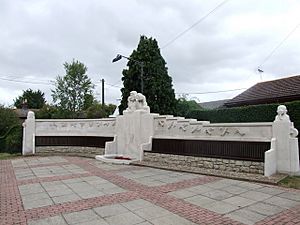Memorial to the Home of Aviation facts for kids
The Memorial to the Home of Aviation is a stone monument in Eastchurch, a village on the Isle of Sheppey in Kent, England. This important memorial was first shown to the public in 1955. It celebrates the very first airplane flights that took place nearby in Leysdown and Eastchurch. These flights were made by members of a club that later became the famous Royal Aero Club of Great Britain in 1910. The memorial also honors the air base that the Royal Navy set up near Eastchurch in 1911.
Contents
Why This Memorial Is Important
The Start of British Aviation
In 1909, the Aero Club created a flying field in Leysdown. Their main building was at Mussel Manor. Close by were sheds where the Short Brothers built early airplanes, using designs from the famous Wright Flyer.
In 1910, the Short Brothers' factory moved to a better spot at Standford Hill, south of Eastchurch. You can still see their old sheds there today. The Aero Club also moved to Stonepitts Farm near Eastchurch.
In 1911, the Admiralty (which was in charge of the Royal Navy) started a flying school at the Eastchurch flying field. This school became very important. In 1912, it became the main base for the Naval Wing of the new Royal Flying Corps. Later, in 1914, it became a Royal Naval Air Service station, and even later, RAF Eastchurch. Today, the Stonepitts site is used as a prison called HM Prison Standford Hill.
How the Memorial Came to Be
People started wanting to remember the important history of this area in the late 1940s and early 1950s. In 1949, a public meeting was held. People suggested building a museum or library as an addition to the Eastchurch village hall.
On February 11, 1950, a letter was published in The Times newspaper. Famous people like Winston Churchill, Lord Brabazon of Tara, and Hugh Oswald Short signed it. They asked the public for help and support to create a memorial.
Unveiling and Rededication
The memorial was built on the west side of Church Road in Eastchurch, where it meets High Street. It is right across from the historic All Saints' Church, Eastchurch. One road from this spot leads towards Leysdown, and another goes towards the old Eastchurch Aerodrome.
The memorial was officially shown to the public on July 25, 1955. Lord Tedder, who used to be the head of the Royal Air Force, did the honors. Fifty years later, in 2005, the memorial was honored again in a special ceremony.
It was first recognized as an important historical building in 1978. In 2018, it was given an even higher status to mark 100 years since the Royal Air Force was created.
What the Memorial Looks Like
Design and Materials
The memorial was designed by Sidney Loweth, who was the county architect for Kent. It has a main wall that faces east, made from a white stone called Portland stone. On this wall, you can see sculptures and a long carving of early airplanes. These were created by the artist Hilary Stratton.
The memorial was built by G.E. Wallis and Sons from Maidstone. The white Portland stone panels at the top are supported by lower walls made of a local stone called Kentish ragstone. These lower walls also have wooden seats built into them. The ground around the memorial is covered with small, rounded stones called flint cobbles. Underneath the central part of the memorial, there's an area covered with blue glass pieces.
Sculptures and Details
The memorial has a central stone stand with a sculpture of Zeus, a god from ancient Greek stories. On either side of this stand are walls with carvings of airplanes from 1909 to 1911. Each wall ends with a stone pillar. If you look at the walls from above, they look like the curved shape of an airplane wing.
The wall on the south side is curved and stays the same height all the way to its pillar, which has a globe on top. Carved stone panels on this wall show different early airplanes, such as an Avro Triplane, Cody 1, De Havilland Biplane No. 1, Howard Wright 1909 Biplane, Dunne D.5, Bristol Monoplane, Handley Page Type E, and a Sopwith-Wright biplane. The central stone stand also has a carving of a Short Flying Boat that looks like it's landing on the blue glass below.
The wall on the north side is straight but steps down to a pillar with a sculpture of an early pilot. This wall has stone panels showing a Short biplane, a Short Type 184 seaplane, Short Twin, Short S.38, Short S.27, the Short Biplane No.2, and Short Biplane No.1.
The Memorial's Message
On the central stone stand, there is an important message carved into the stone. It says: "THIS MEMORIAL / COMMEMORATES / THE FIRST HOME OF / BRITISH AVIATION / 1909 / NEAR THIS SPOT AT / LEYSDOWN EASTCHURCH / (MUSSEL MANOR) (STONEPITTS FARM) / FLIGHTS AND EXPERIMENTS WERE / MADE BY MEMBERS OF THE AERO / CLUB (LATER ROYAL) OF GREAT BRITAIN / ALSO THE ESTABLISHMENT OF THE / FIRST AIRCRAFT FACTORY IN GREAT / BRITAIN BY SHORT BROTHERS 1909 / AND THE FORMATION OF THE FIRST / ROYAL NAVAL AIR SERVICE STATION / 1911".
Other carvings on the memorial tell you the names of the airplanes shown. They also list the names of early pilots like John Moore-Brabazon, Charles Rolls, Frank McClean, A. K. Huntington, J. W. Dunne, Maurice Egerton, T. O. M. Sopwith, Cecil Grace, Alec Ogilvie, Percy Grace, Ernest Pitman, G. P. L. Jezzi, and James Travers.
The memorial also remembers early airplane designers and engineers, including Horace Short, Eustace Short, and Oswald Short. It also lists the first four pilots of the Royal Naval Air Service: Charles Rumney Samson, Arthur Longmore, Reginald Gregory, and Eugene Gerrard.


